https://sputniknews.in/20240412/india-no-first-use-nuclear-policy-remains-unwavering-7118896.html
India's No-First-Use Nuclear Policy Remains Unwavering
India's No-First-Use Nuclear Policy Remains Unwavering
Sputnik India
India's recent tests of nuclear missiles - an Inter Continental Ballistic Missile (ICBM) and another 2000-km range projectile gave fodder about a change in India's nuclear command posture. Sputnik India examines if there's another motive other than "deterrence" behind New Delhi's trials.
2024-04-12T21:00+0530
2024-04-12T21:00+0530
2024-04-13T06:31+0530
sputnik opinion
india
new delhi
pakistan
indian air force (iaf)
agni-v
intercontinental ballistic missile (icbm)
missiles
delhi
islamabad
https://cdn1.img.sputniknews.in/img/07e8/04/04/7036927_50:0:3691:2048_1920x0_80_0_0_a5675a940bf56bf453bfba6d0755c1a7.jpg
India tested its latest ballistic missile Agni-Prime, further bolstering its Strategic Nuclear Command posture last week.Previously New Delhi carried out a successful test of the Multiple Independently Targetable Re-entry Vehicle (MIRV) technology Agni-V intercontinental ballistic missile (ICBM), sending a strong signal to its adversaries in the region.India Introduces Agni-P With a Host of Advanced FeaturesThe Agni-Prime or Agni-P is said to be a 2,000 km range missile armed with the latest technologies that were recently incorporated in the South Asian nation's newer-generation Agni-IV and Agni-V missiles.Like the Agni-IV and Agni-V, the Agni-P features advanced avionics, state-of-the-art navigation systems, the latest propellants, and brand-new motors in rockets.Before its latest test, the Agni-V was last tested in October 2021, whereas the test conducted on March 11 was the maiden trial of the MIRV variant of the missile.On the other hand, the test of the Agni Prime on April 4 was part of user trials of what the Defence Research and Development Organisation (DRDO) said was a new-generation missile. The previous test of the missile was carried out on June 7, 2023.Advantages and Disadvantages of Change in India’s Nuclear PostureDespite the tests of two nuclear warheads in recent weeks, Thakur doesn't see India changing its no-first-use nuclear policy even though geopolitical tensions have been rising nearby following Israel's airstrike on an Iranian diplomatic mission in Syria.Historically, Indian nuclear weapons were aimed at containing Pakistan, also a nuclear weapons owner. Military watchers in India state that the Agni-Prime is primarily meant to counter threats from Pakistan.In this light, the former IAF officer explained that the range of India's existing strategic missiles is enough to deter its adversaries.On being asked to share his views on reports doing the rounds in national media about India's plans to develop a 12,000 km range nuclear missile much like its northern neighbor China, Thakur emphasized that the only advantage of having such a warhead in its arsenal was that it would allow New Delhi to "target its two nuclear-powered neighbors from any direction".Likely, Indian threat perceptions don't warrant developing such a long-range missile, Thakur expressed.
https://sputniknews.in/20240312/how-indias-agni-v-icbm-becomes-nuclear-deterrence-game-changer-6810791.html
india
new delhi
pakistan
delhi
islamabad
china
south asia
Sputnik India
feedback.hindi@sputniknews.com
+74956456601
MIA „Rossiya Segodnya“
2024
Pawan Atri
https://cdn1.img.sputniknews.in/img/07e6/0c/13/139630_147:0:831:684_100x100_80_0_0_8fa2b25903e7787fe6a2698552c167df.png
Pawan Atri
https://cdn1.img.sputniknews.in/img/07e6/0c/13/139630_147:0:831:684_100x100_80_0_0_8fa2b25903e7787fe6a2698552c167df.png
News
en_IN
Sputnik India
feedback.hindi@sputniknews.com
+74956456601
MIA „Rossiya Segodnya“
Sputnik India
feedback.hindi@sputniknews.com
+74956456601
MIA „Rossiya Segodnya“
Pawan Atri
https://cdn1.img.sputniknews.in/img/07e6/0c/13/139630_147:0:831:684_100x100_80_0_0_8fa2b25903e7787fe6a2698552c167df.png
strategic forces command, defence research and development organisation, drdo, agni-prime new generation ballistic missile, agni missile series, agni prime, rapid preparation and launch, operational readiness, nuclear warhead, road-mobile launcher, vijainder k. thakur, india nuclear weapons, inter continental ballistic missile india, india icbm, india strategic command posture, india strategic nuclear command,
strategic forces command, defence research and development organisation, drdo, agni-prime new generation ballistic missile, agni missile series, agni prime, rapid preparation and launch, operational readiness, nuclear warhead, road-mobile launcher, vijainder k. thakur, india nuclear weapons, inter continental ballistic missile india, india icbm, india strategic command posture, india strategic nuclear command,
India's No-First-Use Nuclear Policy Remains Unwavering
21:00 12.04.2024 (Updated: 06:31 13.04.2024) India's recent tests of nuclear missiles - an Inter Continental Ballistic Missile (ICBM) and another 2000-km range projectile gave fodder about a change in India's nuclear command posture. Sputnik India examines if there's another motive other than "deterrence" behind New Delhi's trials.
India tested its latest ballistic missile Agni-Prime, further bolstering its Strategic Nuclear Command posture last week.
Previously New Delhi carried out a successful test of the Multiple Independently Targetable Re-entry Vehicle (MIRV) technology Agni-V intercontinental ballistic missile (ICBM), sending a strong signal to its adversaries in the region.
India Introduces Agni-P With a Host of Advanced Features
The
Agni-Prime or Agni-P is said to be a 2,000 km range missile armed with the latest technologies that were recently incorporated in the South Asian nation's newer-generation Agni-IV and Agni-V missiles.
Like the Agni-IV and Agni-V, the Agni-P features advanced avionics, state-of-the-art navigation systems, the latest propellants, and brand-new motors in rockets.
Before its latest test, the Agni-V was last tested in October 2021, whereas the test conducted on March 11 was the maiden trial of the MIRV variant of the missile.
"As such it was a development flight. There will likely be one or more tests of the MIRV variant of the missile before it is operationally inducted," Defense commentator and former Indian Air Force (IAF) pilot Vijainder K. Thakur told Sputnik India on Friday.
On the other hand, the test of the Agni Prime on April 4 was part of user trials of what the Defence Research and Development Organisation (DRDO) said was a new-generation missile. The previous test of the missile was carried out on June 7, 2023.
Advantages and Disadvantages of Change in India’s Nuclear Posture
Despite the tests of two nuclear warheads in recent weeks, Thakur doesn't see India changing its no-first-use nuclear policy even though geopolitical tensions
have been rising nearby following Israel's airstrike on an Iranian diplomatic mission in Syria.
"I don't believe India will change its no-first-use policy about nuclear weapons. Such a posture would be very destabilizing," Thakur underlined.
"Also, it would shorten the escalation ladder and force us to spend our limited resources on keeping our nuclear weapons in a heightened state of alert. The risks will far outweigh the advantages of such a change in posture," he elaborated.
Historically, Indian nuclear weapons were aimed at containing Pakistan, also a nuclear weapons owner. Military watchers in India state that the Agni-Prime is primarily meant to counter threats from Pakistan.
In this light, the former IAF officer explained that the range of India's existing strategic missiles is
enough to deter its adversaries.
On being asked to share his views on reports doing the rounds in national media about India's plans to develop a 12,000 km range nuclear missile much like its northern neighbor China, Thakur emphasized that the only advantage of having such a warhead in its arsenal was that it would allow New Delhi to "target its two nuclear-powered neighbors from any direction".
Likely, Indian threat perceptions don't warrant developing such a long-range missile, Thakur expressed.
"Instead, India would achieve greater deterrence by developing Hypersonic Glide warheads and quasi-ballistic trajectory missiles than longer-range missiles. Missiles with hypersonic glide warheads and quasi-ballistic trajectories are more difficult to intercept," he concluded.



